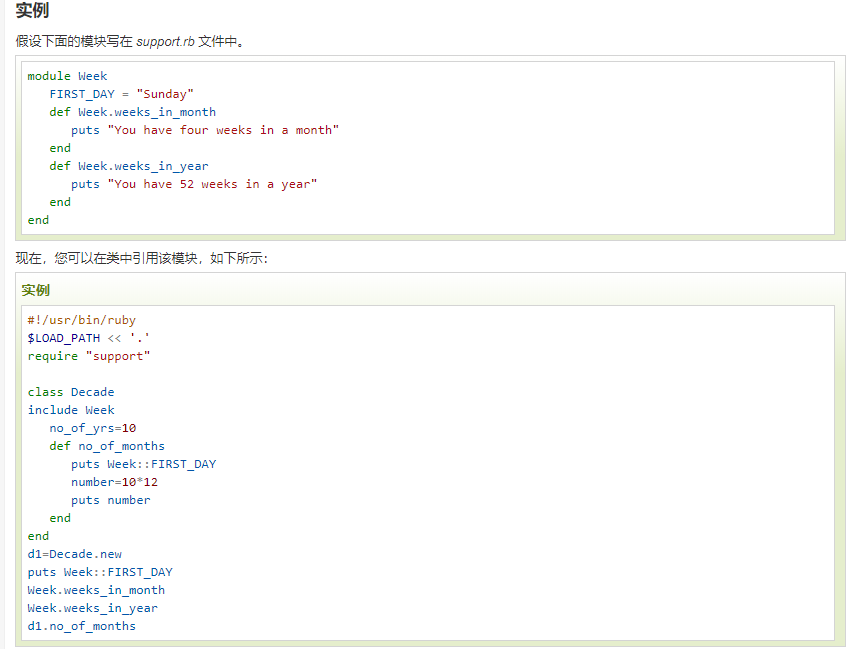Ruby学习中(哈希变量/python的字典, 简单的类型转换)
2024-08-29 03:17:29
一. 哈希变量(相当于Python中的字典)
详情参看:https://www.runoob.com/ruby/ruby-hash.html
1.值得注意的
(1). 创建Hash时需注意
# 创建一个空的Hash
months = Hash.new
puts months
print(months[1]) # 创建一个具有默认值得Hash
months = Hash.new( "month" )
# 或
months = Hash.new "month"
puts months
print(months[1]) 输出结果:
{}
报错 {}
month
(2).Ruby创建一个有数据的Hash时与Python创建一个有数据的dict时的区别
Python:
a = dict(a=1, b=2) # 正确
print(a)
b = dict[a=1, b=2] # 错误
print(b)
c = {["a", "b"]: 1} # 错误
print(c)
Ruby:
a = Hash(a=1, b=2) # 错误
puts a
a = Hash["a" => 1, "b" => 2] # 正确
puts a
b = Hash("a" => 1, "b" => 2) # 正确
puts b
c = Hash("a": 1, "b": 2) # 正确
puts c
d = Hash([1, "he"] => "hai") # 正确
puts d 输出结果:
error
{"a"=>1, "b"=>2}
{"a"=>1, "b"=>2}
{:a=>1, :b=>2}
{[1, "he"]=>"hai"}
(3).Ruby调用hash中的数据与Python调用dict中的数据时的区别
Python:
a = {"a": 1, "b": 2}
print(a["a"])
Ruby:
game = {"疾风剑豪" => "亚索", "流影之主" => "劫", "刀锋之影" => "泰隆"}
puts game
puts game["疾风剑豪"]
user = {name: "进不去啊", age: 18, gender: "男"}
puts user
puts user["name"] # nil
puts user[name] # 报错
puts user[:name] 输出结果:
{"疾风剑豪"=>"亚索", "流影之主"=>"劫", "刀锋之影"=>"泰隆"}
亚索
{:name=>"进不去啊", :age=>18, :gender=>"男"} error
进不去啊
注:Ruby关于字典中的方法大体与Python类似,请放心使用
二. 简单的类型转换
str = ""
puts str
str1 = str.to_i # 转整型
puts str1
str2 = str1.to_s # 转字符串
puts str2
str3 = str1.to_f # 转浮点
puts str3
注:这些转换方法与Python有很大的不同
str = "12345hei"
str1 = str.to_i
str2 = str.to_f
puts str1, str2
puts str1.class, str2.class 输出结果:
12345
12345.0
Integer
Float
str = "hei12345hei"
str1 = str.to_i
str2 = str.to_f
puts str1, str2
puts str1.class, str2.class 输出结果:
0
0.0
Integer
Float
str = "12345hei6789"
str1 = str.to_i
str2 = str.to_f
puts str1, str2
puts str1.class, str2.class 输出结果:
12345
12345.0
Integer
Float
str = "hei12345hei6789"
str1 = str.to_i
str2 = str.to_f
puts str1, str2
puts str1.class, str2.class 输出结果:
0
0.0
Integer
Float
注:经过to_i, to_f转换的字符串如果没有对应的值就会输出0或0.0,并且只会去字符串从首字符向后的所有的连续的数字,有且只取一次
三. 类(class)的再深入
详情参看:https://www.runoob.com/ruby/ruby-class.html
1.值得注意的
(1).Ruby类中的变量

注:Ruby中的类变量看的我有点懵逼(介是嘛呀),所以不推荐使用(别问为什么)
(2).静态类方法
Python:
class Foo(object):
def foo1(self):
print("") @staticmethod
def foo2():
print("") foo = Foo()
Foo.foo2() # 正确
foo.foo2() # 正确
Ruby:
class Game
def initialize(id, title, price) # 构造方法
@id = id
@title = title
@price = price
end def show_game
puts @id + " " + @title + " " + @price
end def self.to_str
puts "I Love This Game"
end
end one = Game.new("one", "LOL", "")
one.show_game
one.to_str # 错误 Game.to_str
Game::to_str 输出结果:
one LOL 0
error
I Love This Game
I Love This Game
注:类的静态方法,直属此类,不能被其它类所引用调用(具体稍后解释)
(3).Ruby 类的继承
class Game
def initialize(id, title, price)
@id = id
@title = title
@price = price
end def show_game
puts @id + " " + @title + " " + @price
end def self.to_str
puts "I Love This Game"
end
end class SteamGame < Game # 关于继承,与Python最大的区别
def steam_info
puts "G胖无敌"
end
end SteamGame.to_str my_game = SteamGame.new("new", "城市:天际线", "")
my_game.show_game
my_game.steam_info 输出结果:
I Love This Game
new 城市:天际线 100
G胖无敌
四. Ruby中的模块
详情参见:https://www.runoob.com/ruby/ruby-module.html
注:Python中也有模块这个概念,但和Ruby中模块的概念不相同
Python:
Python中的模块是以文件.py,且包含了 Python 对象定义和Python语句 Ruby:
模块(Module)是一种把方法、类和常量组合在一起的方式,具体就像是写一个类,只不过把class改为module(简单理解),和Python最大的区别就是Python是以文件作为区分,Ruby是以module作为区分
1.Ruby与Python的最大区别
Ruby中没有多继承!!!
but...
Ruby通过module实现了与多继承相同的思路
module BaseFunc
Version = "0.1.1" def v
return Version
end def add(a, b)
return a + b
end def self.show_version
return Version
end # 讲v方法定义范围静态方法
module_function :v
end puts BaseFunc::Version
puts BaseFunc.show_version
puts BaseFunc::show_version
puts BaseFunc.v
# puts BaseFunc.add(20 + 30) # 错误 class BaseClass
include BaseFunc
end puts "++++++++++++++++++++"
# puts BaseClass.show_version # 错误
# puts BaseClass.v # 错误
puts BaseClass::Version
my_cls = BaseClass.new
puts my_cls.add(20, 30)
# puts my_cls.show_version # 错误
module A
def a1
end
def a2
end
end
module B
def b1
end
def b2
end
end class Sample
include A
include B
def s1
end
end samp=Sample.new
samp.a1
samp.a2
samp.b1
samp.b2
samp.s1
Ruby多继承实例
2.Ruby关于模块的引用
(1).文件中引用
Ruby require 语句
语法:require filename
注:相当于Python中的import引入模块
实例:
require 'trig.rb'
require 'moral'
注:可以引入文件.rb或直接引入模块中的方法
(2).类中引用

。。。
未完待续
最新文章
- 功能实现:PLC对LPC的音量控制
- git 删除分支
- linux安装oracle11g
- 仿网易新闻 ViewPager 实现图片自动轮播
- VS2010 使用 EntityFramework For SQL Server Compact 4.0
- 纯手工全删除域内最后一个EXCHANGE--How to Manually Uninstall Last Exchange 2010 Server from Organization
- STM32随记
- 基于excel9.h的excel处理
- unity3d 学习过程记录
- jQuery实现父窗口的问题
- java基础(三章)
- 关于jQuery.click()函数
- MVCC的一些理解
- firewall centos
- K8S 调度器,预选策略,优选函数
- C++ Primer读书笔记(1)
- Hiero中的Events机制
- JAVA 关于JNI本地库加载
- PHP使用swoole来实现实时异步任务队列
- angular惰性加载拓展剖析